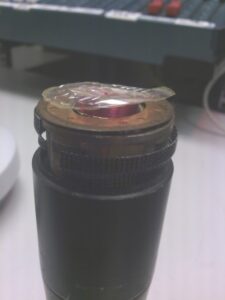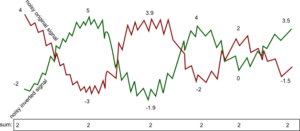I finally had a bit more time this morning to write a bit more in the A/V manual. There’s lots of bits and pieces of documentation on board, but no comprehensive single getting started manual. So I’m writing one, bring together bits and pieces from all over the place, sorting out what documentation there is, updating schematics, etc.
Anyway, here’s the rough version on the article I just wrote about how balanced sound cables work. It’s pretty much my standard explanation of Balanced Audio, and aimed at people coming to A/V from a non-techy musical background, rather than for Electronics Engineers.
You may find it interesting. Then again, you may not.
—–
Sound is basically vibrations in the air.
TODO: more details, pingpong ball analogy?
 |
Inside an (SM57) Microphone head.
That is the bit of plastic and the coils! |
This translates really easily into an analogue electrical signal: you simply turn the air vibrations into voltage vibrations. A Dynamic microphone does this by having a small bit of paper (or plastic) which vibrates with the air around it, and pushes against a very small copper coil which, moving inside a magnetic coil itself, generates a very-very-very small amount of electrical current.
TODO: more pictures.
This gets dumped down a wire, which gets amplified by (you guessed it) an amplifier into a very big amount of electrical current, which then drives a big electromagnet inside a speaker, which pushes another copper coil around, which is attached to another big bit of paper (the speaker cone), which causes the air around the speaker to vibrate – with the same vibrations that the microphone vibrated with, just bigger.
Simple, isn’t it? (well. Kind of.)
The trouble with simply dumping an audio signal down a cable, and picking it up at the other end is that your signal line, and return (usually ground) will pick up noise (say from A/C mains electricity, fluorescent lights, dimmers, mobile phones, etc) along the way.
Here’s an original signal:
And here’s some noise:
And the result:
This is a Bad Thing™.
So some clever engineers, back in the deep recesses of time figured out the following: You could take a signal, and before sending down the wire where it could pick up noise, invert it:
If we add the signal to the inverse, you get a grand result of nothing (e.g. -3 + 3 = 0).
Now, if we throw these two signals down a pair of very similar cables twisted round and round each other like crazy, then they’ll both pick up noise pretty much the same as each other:
Note that 3 (the original) + 1 noise = 4,
while -3 (the inverse) + 1 noise = -2. NOT -4!
This is really cool, because if we add these two signals together, we don’t get 0 anymore, we get no original signal, but you do get the noise (doubled).
So we’ll use our amazing maths skills again, and divide this doubled noise in half. (2/2 = 1).
And we can subtract this 1 noise from the noisy original signal (4-1=3)
Voila! The original clean signal is back again.
This is (roughly speaking) how balanced audio works. And since almost all professional audio equipment runs with balanced circuitry, all we need to do is make sure the cables are in good shape, and then everything works magically with hardly any noise.
This is why for balanced cables (XLR/Mic, or TRS jack) you have 3 pins: +, -, and ground. The ground is connected to a wire-mesh sheath around the other two, to try and keep as much noise away as possible.
(Technically, you don’t need to invert the signal, you could just use an empty zero, but for various impedance, op-amp, techy reasons, it works better if you do.)
Sometimes the ground wire will pick up noise itself, or due to being connected to different grounds at both ends of the circuit (say a piano on stage, and the A/V room sound desk) it will end up with a bit of random leaked current running down itself. This can show up as noise, so you often use a Ground-Lift switch to disconnect the ground at one end or the other, which can sometimes help.
A DI box takes an unbalanced signal, and turns it into a balanced one, which means you can send a signal a long way without noise.
Remember how the two wires have to be twisted together like crazy? This is so that if there is some noisy thing (like a flurescent light) nearby, both wires will be equally effected. This is so important, that for broadcast audio, sometimes cables with 4 or more wires are used. The + signal on 1 & 3, the – signal on 2 and 4, and then all of these are twisted together. There are brand names of these cables such as QuadStar, etc. Usually this is somewhat overkill for regular live sound though, as the cabling is much stiffer and harder to use day to day.
——–
So, what do you think?





